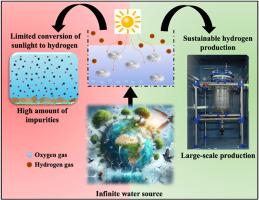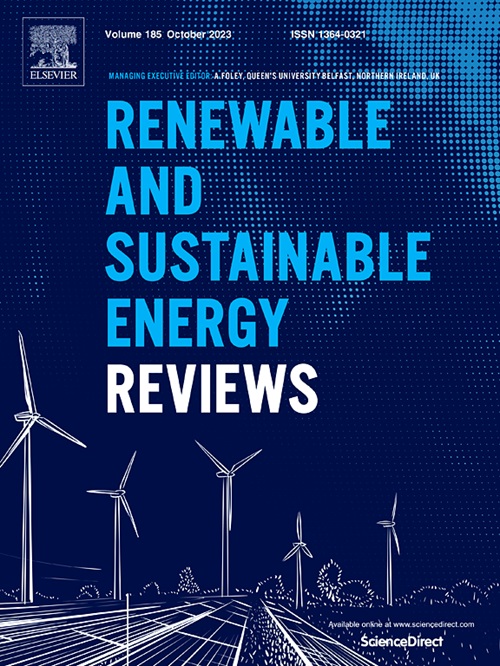A review on photocatalytic seawater splitting with efficient and selective catalysts for hydrogen evolution reaction
IF 16.3
1区 工程技术
Q1 ENERGY & FUELS
引用次数: 0
Abstract
The rising global demand for clean and renewable energy has spurred interest in innovative technologies capable of addressing both energy production and environmental challenges. Among these, photocatalytic seawater splitting has emerged as a highly promising approach for generating hydrogen, a clean fuel, by harnessing sunlight. Unlike traditional water-splitting techniques that depend on freshwater resources, seawater splitting offers a sustainable alternative by utilizing the vast and readily available oceanic reserves. This process leverages advanced photocatalytic materials, such as metal oxides (e.g., TiO₂, ZnO), perovskites, and 2D materials like graphitic carbon nitride (g-C₃N₄), to enhance the efficiency of the hydrogen evolution reaction (HER). This review provides a comprehensive analysis of the latest advancements in photocatalytic seawater splitting, focusing on catalyst design, performance optimization, and overcoming key challenges such as corrosion, photocatalyst stability, and the detrimental effects of seawater components, including chloride ions and metal cations, on hydrogen production. Special attention is given to the role of novel materials, such as nanosheet arrays, metal-organic frameworks (MOFs), and defect-engineered catalysts, in improving charge separation, reducing recombination rates, and enhancing light absorption under solar irradiation. Furthermore, the review addresses the impact of seawater composition, including the presence of ions such as Na⁺, Mg2⁺, and Ca2⁺, on the photocatalytic process, and discusses strategies to mitigate undesirable side reactions, such as chlorine evolution. The commercial potential of photocatalytic seawater splitting is also considered, highlighting its scalability and integration into renewable energy infrastructures to produce hydrogen as a viable alternative to fossil fuels.

利用高效和选择性催化剂进行光催化海水分离以促进氢气进化反应综述
全球对清洁和可再生能源的需求不断增长,激发了人们对既能解决能源生产问题又能应对环境挑战的创新技术的兴趣。其中,光催化海水裂解技术已成为利用太阳光生成氢这种清洁燃料的一种极具前景的方法。与依赖淡水资源的传统水分离技术不同,海水分离技术利用了大量随时可用的海洋储量,提供了一种可持续的替代方法。该工艺利用先进的光催化材料,如金属氧化物(如 TiO₂、ZnO)、过氧化物和二维材料(如氮化石墨碳(g-C₃N₄)),来提高氢进化反应(HER)的效率。本综述全面分析了光催化海水分离的最新进展,重点关注催化剂设计、性能优化以及克服腐蚀、光催化剂稳定性等关键挑战,以及海水成分(包括氯离子和金属阳离子)对制氢的不利影响。报告特别关注了纳米片阵列、金属有机框架 (MOF) 和缺陷工程催化剂等新型材料在改善电荷分离、降低重组率和提高太阳照射下的光吸收方面的作用。此外,综述还探讨了海水成分(包括 Na⁺、Mg2⁺ 和 Ca2⁺等离子的存在)对光催化过程的影响,并讨论了减轻氯进化等不良副反应的策略。此外,还考虑了光催化海水裂解的商业潜力,强调了其可扩展性以及与可再生能源基础设施的整合,以生产氢气作为化石燃料的可行替代品。
本文章由计算机程序翻译,如有差异,请以英文原文为准。
求助全文
约1分钟内获得全文
求助全文
来源期刊

Renewable and Sustainable Energy Reviews
工程技术-能源与燃料
CiteScore
31.20
自引率
5.70%
发文量
1055
审稿时长
62 days
期刊介绍:
The mission of Renewable and Sustainable Energy Reviews is to disseminate the most compelling and pertinent critical insights in renewable and sustainable energy, fostering collaboration among the research community, private sector, and policy and decision makers. The journal aims to exchange challenges, solutions, innovative concepts, and technologies, contributing to sustainable development, the transition to a low-carbon future, and the attainment of emissions targets outlined by the United Nations Framework Convention on Climate Change.
Renewable and Sustainable Energy Reviews publishes a diverse range of content, including review papers, original research, case studies, and analyses of new technologies, all featuring a substantial review component such as critique, comparison, or analysis. Introducing a distinctive paper type, Expert Insights, the journal presents commissioned mini-reviews authored by field leaders, addressing topics of significant interest. Case studies undergo consideration only if they showcase the work's applicability to other regions or contribute valuable insights to the broader field of renewable and sustainable energy. Notably, a bibliographic or literature review lacking critical analysis is deemed unsuitable for publication.
 求助内容:
求助内容: 应助结果提醒方式:
应助结果提醒方式:


